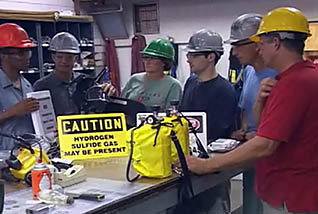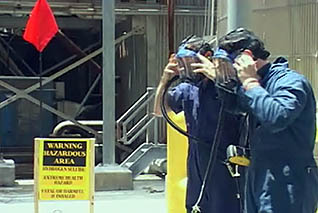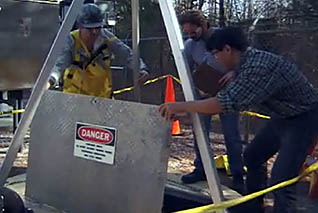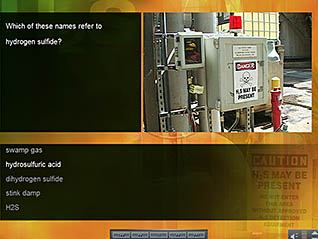Hydrogen Sulfide Employee Training
- Product ID
- erishset
- Training Time ?
- 54 to 108 minutes
- Language(s)
- English
- Video Format
- Standard Definition
- Required Plugins
- MasteryNet Player
- Lesson Interactions
- 12
- Quiz Questions
- 30
- Closed Captioning



The rotten egg smell that develops at a job site isn't just an unpleasant sensory experience; it is the first sign of H2S. Hydrogen sulfide (H2S), or swamp gas, is classified as a chemical asphyxiant. Chemical asphyxiants reduce the body's ability to absorb, transport or utilize inhaled oxygen. Those who work with or near sewage, gas and oil, or natural decaying matter such as animal waste and compost are at risk for HS2 exposure. Training is the first line of defense against this deadly gas.
This H2S safety training course provides employees with an understanding of Hydrogen Sulfide, the signs of exposure, limits of exposure, safety protocols and evacuation procedures. This course supports your efforts to align and comply with OSHA's H2S training requirements.
Beyond meeting requirements this training may help save lives, as exposure to H2S can quickly result in death. Learn how to work safely when presented with the hazard of hydrogen sulfide.
![]() This course is in the Advantage™ format, to read about Advantage™ features click here.
This course is in the Advantage™ format, to read about Advantage™ features click here.



- Install on any SCORM LMS
- Rich multimedia presentation with interactions and quiz
- Print certificate and wallet card
- You have 30 days to complete the course
For all workers in the oilfield, pipeline, and petrochemical industry.
-
Recognize hydrogen sulfide.
- Select characteristics of hydrogen sulfide.
- Recall common names of hydrogen sulfide.
- List areas where hydrogen sulfide may exist.
-
Appreciate the hazards of hydrogen sulfide.
- Identify hazards of hydrogen sulfide.
-
Recognize signs and symptoms of exposure from hydrogen sulfide.
- Choose the most common method of exposure to hydrogen sulfide.
- List symptoms of exposure to hydrogen sulfide at concentrations up to 10 parts per million.
- Acknowledge conjunctivitis as a sign of exposure at levels of 50 parts per million or above.
- List symptoms of conjunctivitis.
- Identify the IDLH exposure level.
- Identify symptoms of exposure to hydrogen sulfide at 10 - 50 ppm.
- List factors that may affect symptoms of exposure.
-
Work safely within the hydrogen sulfide exposure limits.
- Differentiate a ceiling concentration from a time-weighted average.
- Define a threshold limit value.
- Choose ACGIH's recommended minimum time limits between short-term exposures.
-
Be aware of general respirator procedures and uses.
- Recall that each cartridge in a chemical cartridge respirator is designed for a specific chemical.
- Recognize the consequences of break-through caused by extending a cartridge's usable service life.
- State the length of air time available in a traditional SCBA respirator.
- Choose the proper action to take when an SCBA alarm sounds.
- List requirements for all employees using a respirator.
-
Select the proper respirator for the job.
- Select the proper type of respirator when H2S concentrations are above 100 parts per million.
- Identify the proper respirators to use when entering an area with an unknown concentration level of H2S.
-
Follow guidelines to enter a confined space only when trained and authorized.
- Determine why hydrogen sulfide is commonly found at the bottom of a confined space.
- List employee requirements needed to enter and work within a confined space.
-
Utilize hydrogen sulfide monitoring and warning systems.
- Identify the warning systems available for areas with potential H2S presence.
- Recognize that a variety of systems are used to warn against the dangers of hydrogen sulfide exposure.
-
Properly evacuate areas containing unsafe levels of hydrogen sulfide.
- Identify the direction to move in the event of an evacuation.
- Select the proper minimum distance of a briefing area during the evacuation of a building.
- Choose the appropriate action to take if a co-worker becomes unconscious from exposure to hydrogen sulfide.
-
Follow safe work practices when working with or around hydrogen sulfide.
- List safe practices to follow whenever working with or around hydrogen sulfide.
© Mastery Technologies, Inc.




